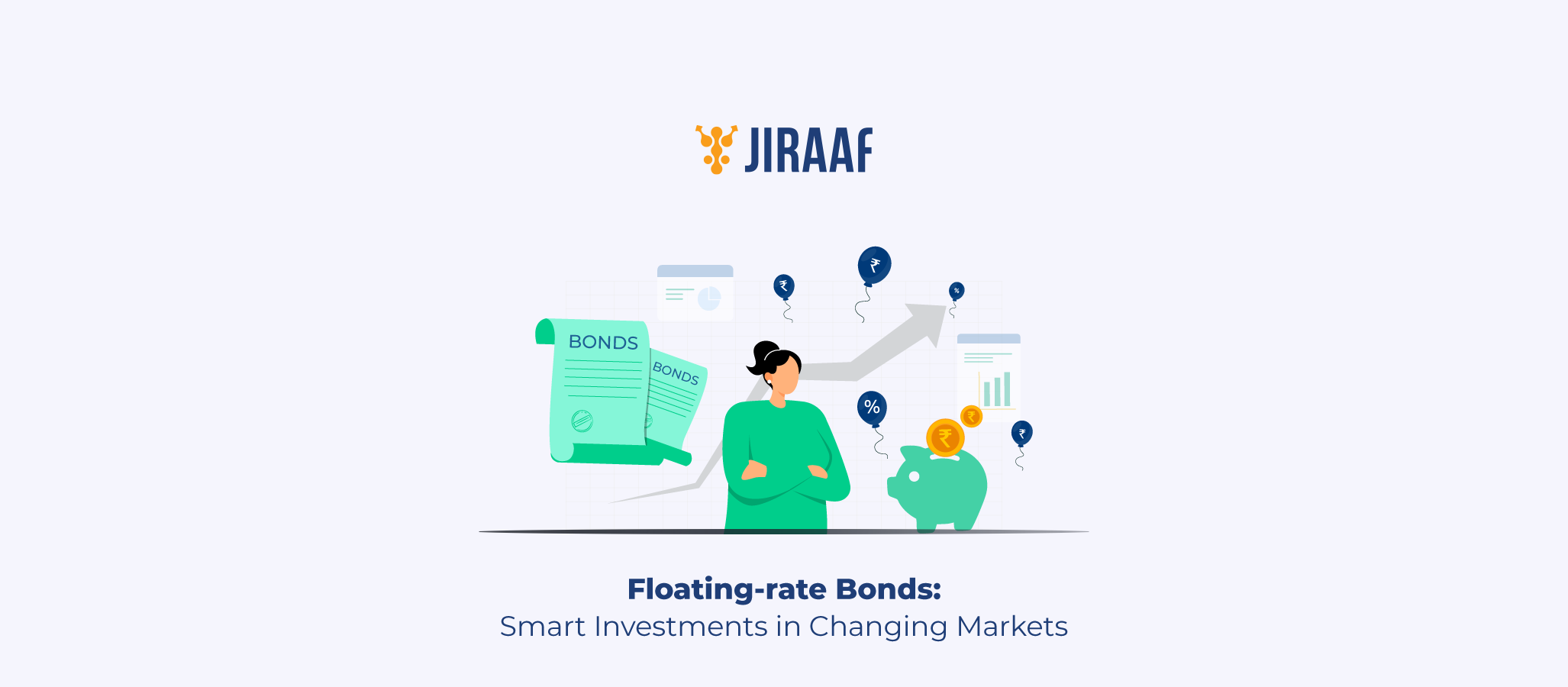Imagine a financial tool that seamlessly adjusts itself to the changing rhythm of interest rates, offering adaptability without compromising on stability. In an era where even the smallest shifts in economic conditions can ripple through portfolios, floating-rate bonds emerge as a solution designed for maintaining stability in returns.
Whether you’re safeguarding hard-earned wealth or pursuing steady growth, floating-rate bonds align themselves with the demands of a dynamic financial environment, while keeping risks in check.
Floating-rate bonds adjust their returns in real time, correlating directly with market rates. This allows investors to protect their portfolios from rising interest rates. For those looking to hedge against volatility, floating-rate bonds can be a flexible addition to the portfolio that helps manage rate shifts while offering growth potential.
Let’s explore these bonds in greater depth, uncover their benefits and risks, and how they can help stabilize your portfolio during interest rate fluctuations.
What is a Floating-rate Bond?
A floating-rate bond is a debt instrument whose interest rate fluctuates over time, typically in response to changes in a benchmark rate like LIBOR or SOFR. These bonds offer a base rate plus an additional spread determined at the time of issuance.
Their primary advantage over traditional fixed-rate bonds is that floating-rate bonds adjust their returns in line with market conditions, making them particularly appealing when interest rates rise.
How do Floating Rate Bonds Work?
Floating-rate bonds reset their interest rates at specified intervals based on fluctuations in the reference rate. If the benchmark rate rises, the interest rate paid to bondholders increases, offering better returns. Conversely, if rates fall, the bond’s yield decreases.
The reset frequency—whether quarterly, semi-annually, or annually—also significantly affects how these bonds respond to market conditions. The more frequent the reset, the quicker the bond’s return adapts to interest rate changes.
Fixed-rate Bonds vs. Floating-rate Bonds
While fixed-rate bonds offer consistent returns, they remain static, even when interest rates rise. Floating-rate bonds adjust to market conditions, ensuring that returns increase when interest rates rise but may fall when rates decrease. This flexibility makes floating rate bonds an attractive option for those seeking protection from interest rate volatility.
Types of Floating Rate Bonds
Several types of floating-rate bonds are available, each catering to different investor preferences and risk appetites. Let’s explore some of the most common ones:
- Government-issued Floating-rate Bonds: Backed by sovereign entities, these bonds offer high credit safety and are ideal for conservative investors.
- Company Floating-rate Bonds: Issued by corporations, these bonds typically offer higher yields but carry added credit risk.
- Subordinated Floating-rate Bonds: Issued by financial institutions, these higher-risk, higher-reward bonds can help you fulfil capital requirements, often offering higher yields.
- Callable Floating-rate Bonds: Redeemable early by issuers, usually during periods of declining interest rates, these bonds can limit your returns.
- Non-callable Floating-rate Bonds: These bonds are not subject to early redemption, offering stability for long-term investors.
Example of a Floating Rate Bond
Let’s look at how floating-rate bonds work with a simple, relatable example, using an RBI floating-rate bond linked to the National Savings Certificate (NSC) interest rate.
Imagine you invest ₹100,000 in a floating-rate bond issued by the Reserve Bank of India (RBI) on July 1, 2020. The interest rate on this bond is linked to the NSC interest rate, with an added 0.35% spread. If the NSC rate increases, your bond interest payments will also increase, offering a natural protection against rising rates.
How Does This Work?
The initial interest rate on your bond is calculated by taking the current NSC interest rate (for example, 6.80%) and adding the spread of 0.35%. So, in this case, your bond’s interest rate is 7.15% (6.80% + 0.35%).
Floating-rate bonds typically pay interest every six months. So, if you invested ₹100,000, your semi-annual interest payment would be ₹3,575 (7.15% divided by two for the six months).
What Happens When Interest Rates Change?
Every six months, the RBI readjusts the bond’s interest rate based on any changes in the NSC rate. This means your payments could go up if the NSC rate rises.
For example, for Jan-Jun 2023, the NSC rate increases to 7.00%. With a spread of 0.35%, your new interest rate becomes 7.35%. This means your semi-annual payment increases to ₹3,675.
For Jul-Dec 2023, if the NSC rate increases further to 7.50%, your new bond rate becomes 7.85%. Now, your semi-annual payment is ₹4,025.
In simple terms, as interest rates rise, your floating-rate bond payments rise, too, offering you protection from inflation and increasing interest rates.
Advantages of Floating Rate Bonds
Investing in floating-rate bonds offers several key advantages that can complement an investor’s broader portfolio strategy:
Protection Against Rising Interest Rates
Since the interest rate adjusts based on benchmarks, bondholders benefit from increased returns when rates rise.
Potential for Higher Returns
In rising interest rate environments, floating-rate bonds can outperform fixed-rate bonds as their rates adjust accordingly.
Diversification
Adding floating-rate bonds to your portfolio helps introduce interest rate variability, increasing predictability in outcomes in a fixed-income portfolio.
Liquidity and Flexibility
Many floating-rate bonds are traded in secondary markets, allowing quicker access to funds.
Portfolio Resilience
These bonds provide stability to your portfolio even when other investments experience downturns due to interest rate changes.
Risks of Floating Rate Bonds
While floating-rate bonds offer distinct advantages, they are not without risks. Some risks investors might need to face are:
Declining Interest Rates
If the benchmark rate falls, the returns on floating-rate bonds will decrease accordingly.
Limited Predictability
Return variability might not align with every investor’s financial goal, especially those seeking predictable income.
Credit Risk
Corporate floating-rate bonds carry the risk of issuer default, which should be considered when choosing bonds.
Call Risk
Callable floating-rate bonds expose investors to early redemption, limiting returns if interest rates decline.
Being mindful of these risks and evaluating them in the context of your investment strategy is crucial for successful floating-rate bond investing.
Who Should Consider Investing in Floating Rate Bonds?
Floating-rate bonds are ideal for:
Retail investors Seeking Inflation Protection
These bonds automatically adjust to rising rates, offering protection against inflation and preserving purchasing power.
Financial Planning for Short-to-medium-term Goals
Floating-rate bonds are suited for investors with time-sensitive goals who need flexibility and protection against rate shifts.
High Net-Worth Individuals (HNIs)
Floating-rate bonds are often used by HNIs to complement other fixed-income instruments, offering an additional layer of diversification and portfolio resilience.
How to Invest in Floating Rate Bonds
Investing in floating-rate bonds can be approached in several ways:
- Direct Purchase: You can buy these bonds directly from government auctions or corporate issuers, although availability may vary depending on the bond type.
- Brokers: You can access floating-rate bonds in the secondary market through brokers and other intermediaries, offering an easy route to diversify your holdings.
- Mutual Funds/ETFs: You can explore a wide range of bonds and diversify risk through mutual and exchange-traded funds (ETFs) that focus on floating-rate securities.
Tips to Choose the Right Floating-rate Bond
Here are some simple, actionable tips to help you choose the right floating-rate bond:
- Monitor the Benchmark Rate’s Sensitivity
Floating-rate bonds are tied to benchmarks. Stay updated on central bank policies and macroeconomic trends, as these directly influence benchmark movements and your bond’s returns.
- Assess the Issuer’s Spread
The spread added to the benchmark reflects the issuer’s risk. Corporate bonds usually offer higher spreads than government bonds, compensating for credit risk. Ensure the spread aligns with your risk tolerance and goals.
- Consider Reset Frequency
Shorter reset periods (quarterly) offer quicker adjustments to rate changes, while longer ones (annually) provide smoother returns in stable rate environments. Choose based on your need for responsiveness to market shifts.
- Watch for Rate Caps and Floors
Some bonds have caps (max rate) or floors (min rate), which limit potential returns or losses. Know these limits to ensure these options fit your capital market outlook and investment strategy.
- Check Liquidity and Market Depth
Liquidity varies by each issuer and bond type. Government bonds typically have better liquidity than corporate or subordinated ones. Assess the secondary market conditions before committing to any option.
- Understand Tax Implications
The tax treatment on floating-rate bonds can vary. Government-backed floating-rate bonds may offer tax exemptions or lower capital gains tax; factor in tax advantages of different floating-rate bonds when considering these as part of your portfolio.
- Evaluate Issuer Stability
A stronger issuer is less likely to face disruptions in coupon payments or credit downgrades for corporate bonds. Assess the issuer’s financial health and liquidity needs.
- Consider Duration and Portfolio Fit
The duration of floating-rate bonds changes with interest rate movements. They help manage rate risk during hikes but may lose effectiveness in declining or stable rate environments. Align with your portfolio’s duration strategy.
Concluding Thoughts
Choosing the right floating-rate bond is about balancing risk with reward. Staying informed about market trends and issuer health can help you make smarter decisions. With the right strategy, floating-rate bonds can add much-needed flexibility to your portfolio, adjusting to interest rate shifts and providing growth opportunities.
Always ensure your choices align with your financial goals and risk tolerance and keep your investment plan adaptable to changing market conditions.
FAQs related to Floating-rate Bonds
What is the Difference Between a Floating-rate Bond and a Fixed-rate Bond?
The primary difference lies in the interest rate structure. A fixed-rate bond offers a constant interest rate throughout its term, providing predictable returns. In contrast, a floating-rate bond’s interest rate adjusts periodically based on a benchmark rate, such as LIBOR or SOFR. This means the yield on floating-rate bonds fluctuates with changes in market interest rates.
How Are Interest Rates on Floating Rate Bonds Calculated?
The interest rate on floating-rate bonds is typically determined by adding a fixed spread (or margin) to a benchmark rate, like LIBOR or SOFR. For example, a bond might offer an interest rate of LIBOR + 2%. As the benchmark rate changes, so does the interest rate on the bond, adjusting periodically (usually every 3 or 6 months).
Are Floating Rate Bonds a Safe Investment?
Floating-rate bonds are often considered less risky than fixed-rate bonds in rising interest rate environments because their interest rates adjust with market conditions. However, they still carry risks such as credit risk (especially for corporate floating-rate bonds) and potential liquidity risk. As with any investment, it’s important to assess the specific bond’s issuer and terms.
Can Individuals Buy Floating Rate Bonds Directly?
Yes, individuals can buy floating-rate bonds directly, either through brokers or bond markets. However, these bonds may not be as widely available to retail investors as traditional fixed-rate bonds. Additionally, investors may need to meet specific criteria or invest in mutual funds or ETFs that include floating-rate bonds.
Discover fixed income investments with Jiraaf, a SEBI registered online bonds platform that educates and brings access to a wide array of bonds. Sign up today to explore diversified fixed income investment opportunities to support your goal-based wealth creation journey. Start investing!













 help@jiraaf.com
help@jiraaf.com